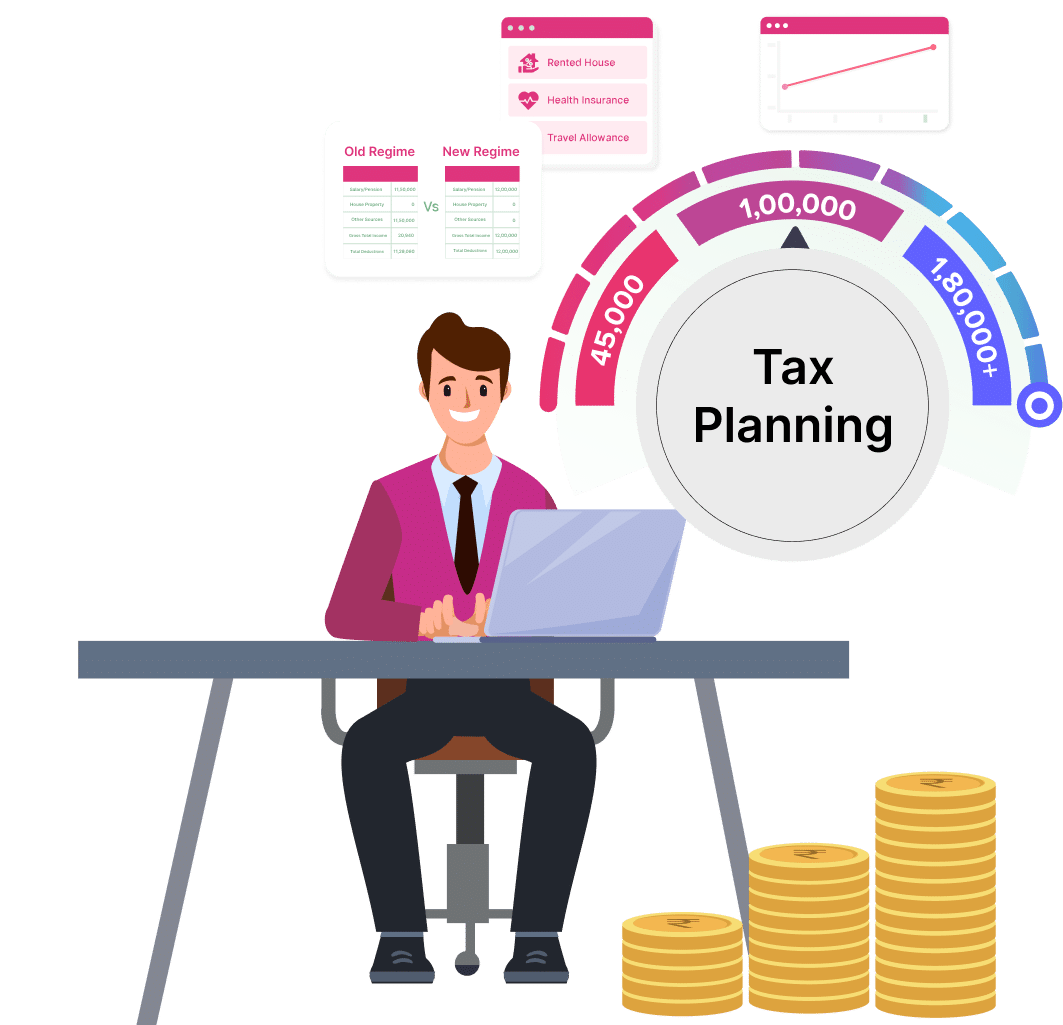Income Tax eFiling
File your tax return hassle free with us
- File your income tax return hassle-free
- Maximize your tax savings
- Get 100% data security & privacy assurance



Joined by Thousands

Trusted by 1000+
Secure & Safe
4.8 Star User Rating
Plans
Income Tax efiling
Effortlessly file your return and get maximum refund with India’s top e-filing website.
Self E-Filing
Step by step ITR filing
Get Expert assistance
Hassle free filing
Filing by Expert
Guidance on ITR filing
Get Expert assistance
Hassle free filing
Tax Planning
Tips to save tax
Hacks to build wealth
Tips 80C
Filing by Expert
Salary
Salary less than 50 lakhs
Interest Income
House Property
Capital Gain from Stocks, Mutual Funds and Property
Income earned outside India
DTAA Guidance
House Property
Salary more than 50 lakhs
Interest Income
House Property
Capital Gain from Stocks, Mutual Funds and Property
Income earned outside India
DTAA Guidance
Capital Gain
Salary more than 50 lakhs
Interest Income
House Property
Capital Gain from Stocks, Mutual Funds and Property
Income earned outside India
DTAA Guidance
Foreign Income
Salary more than 50 lakhs
Interest Income
House Property
Capital Gain from Stocks, Mutual Funds and Property
Income earned outside India
DTAA Guidance
Professionals, Small Business & Freelancers
Income from Profession/ small business
Applicable Annual turnover upto 2Cr for business and 50 lakhs for professionals.
Includes Salary, House Property, Other income and Capital Gain
Security traders
Profit/loss from F&O or intraday trading
Preparation of Balance Sheet & P&L
Includes Salary, House Property, Other income and Capital Gain
Business Tax Return
Business Income
Preparation of Balance Sheet & P&L
Includes Salary, House Property, Other income and Capital Gain
Audit fee not included
Self E-Filing
S No.
Step
Guide To File ITR Online
Step 1
Log on to the portal
Log on to the Income Tax Department portal (Link) for filing returns online. Register using your Permanent Account Number (PAN) if not registered or Enter your Login Credentials.
Step 2
E file Return
Under 'E-file', go to File Income tax return and select relevant assessment year and select the appropriate Income Tax Return (ITR) form.
Step 3
Enter details in ITR Form
Enter the relevant details based on the information available
Step 4
Compute all relevant tax details
Compute tax payable, pay tax and enter relevant challan details in the tax return. If you do not have a tax liability, you can skip this step.
Step 5
Confirm the above details
Confirm the details entered by you and save the form
Step 6
Submit return
Go the 'Submit Return' section and submit the form
Step 7
Confirmation from ITR verification
A message confirming successful e-filing will be flashed on your screen. The acknowledgement form - ITR-Verification is generated and the same can be downloaded.
Step 8
E-verify Return
"You can e-verify the return based on the available options or can send a physical copy of the ITR acknowledgement to CPC, Bengaluru"
READ CUSTOMER REVIEWS
Feedback from our Customers
1000+ Reviews Of Delighted Clients with Google 4.8 Rating
Guide on ITR Filing for AY 2024-25
ITR-1
- For individuals with income up to Rs. 50 lakhs, from salary, pension, one house property, and other sources
- Cannot be used by individuals who have earned income through more than one house property, capital gains, or business/profession
ITR-2
ITR-3
- For individuals with income up to Rs. 50 lakhs, from salary, pension, one house property, and other sources
- Cannot be used by individuals who have earned income through more than one house property, capital gains, or business/profession
ITR-4
ITR-5
ITR-6
ITR-7
ITR-1
ITR-2
ITR-3
ITR-4
ITR-5
ITR-6
ITR-7
Tax Slab
Let us take a look at the income tax slabs for FY 2023-24 (AY 2024-25) under both tax regimes for resident individuals aged less than 60 years-
| Net Taxable Income | New Tax Regime Income Tax Slab Rates FY 2022-23 | Old Tax Regime Income Tax Slab Rates FY 2022-23 |
|---|---|---|
| Up to Rs 2.5 lakh | Exempt | Exempt |
| Rs 2,50,001 to Rs 3 lakh | 5% | |
| Rs 3,00,001 to Rs 5 lakh | 5% | |
| Rs 5,00,001 to Rs 6 lakh | 20% | |
| Rs 6,00,001 to Rs 9 lakh | 10% | |
| Rs 9,00,001 to Rs 10 lakh | 15% | |
| Rs 10,00,001 to Rs 12 lakh | 30% | |
| Rs 12,00,001 to Rs 15 lakh | 20% | |
| Over Rs. 15 lakhs | 30% |
In case of Senior Citizen and super senior Citizen, the Basic Exemption limit would be 3,00,000 and 5,00,000 Lakhs respectively.
Our Valued Clients
Frequently Asked Questions
What is income tax return (ITR)?
An income tax return is a form that an individual is required to submit to the Income Tax Department in India. It contains information related to the individual’s income and taxes paid, starting from 1st April to 31st March of the financial year. There are seven ITR forms prescribed by the Income Tax Department according to the amount of income, income source, and the category to which the taxpayer belongs.
How can I file an income tax return in India?
You can file your income tax returns online, either on the income tax department’s website or with the help of various authorized agencies such as chartered accountants and online tax filing platforms like Advalyze.
If my company deducts TDS, do I still have to file my ITR?
Yes, deducting TDS and filing a tax return are two separate legal compliances. Income tax should be paid on your taxable income as per the provisions of the Income Tax Act. You file a tax return to show that you have paid all the tax you needed to pay. Additionally, your company may only deduct taxes on your salary portion, but you might have other sources of income as well, such as selling shares in the equity market, rental income, etc.
Which income tax return form should I select for e-filing?
There are seven forms – ITR 1, 2, 3, 4, 5, 6, and 7 – notified by the government for different categories of taxpayers. The appropriate form should be selected based on the amount of income, income source, and the category to which the taxpayer belongs.
How do I pay tax to the government?
You can pay tax to the government directly on the Income Tax Department website using your net-banking account or debit card using challan 280.
What is ITR-V?
ITR-V is a 1-page document that you receive after e-filing your income tax return and where e-verification is pending. You can verify your income tax return through offline or online mode. There are various methods of online verification. However, to verify your return offline, you must print, sign, and send the ITR-V to the Income Tax Department within 30 days from e-filing your tax return.
Is it necessary to attach any documents along with the return of income?
No, a taxpayer does not need to attach any documents while filing their tax return. However, it is recommended to have all the documents with you in case the tax department might ask for these details in the future.
What is the period for which a person's income is taken into account for the purpose of income tax?
Income tax is levied on the annual income of a person. Under the Income-tax law, the period is starting from 1st April and ending on 31st March of the next calendar year. The Income-tax law classifies the year as the previous year or current financial year and assessment year.
If I have paid excess tax, how will it be refunded to me?
You can claim a refund of the excess tax paid by filing your Income-tax return. It will be refunded to you by crediting it to your bank account through ECS transfer. It is important to pre-validate your bank account details before filing your income tax return. You can check the status of your IT refund at https://tin.tin.nsdl.com/oltas/refund-status-pan.html.
Which avenues allow deduction under Section 80C?
The list of eligible deductions commonly available under Section 80C is as follows:
- Investments made towards the following:
- Life insurance policies
- ELSS schemes
- PPF
- EPF
- Sukanya Samriddhi Yojana
- 5-year bank or post office deposit
- Senior Citizen Saving Scheme
- NSC or KVP
- Expenses incurred on the following:
- Principal repayment of home loan
- Stamp duty and registration charges on a property
- Tuition expenses paid for up to 2 children
Is it necessary to file a return of income when I don’t have any positive income?
You must file your return before the due date if you have sustained a loss in the financial year and if you want to carry it forward to the subsequent year for adjustment against the subsequent year’s income. Loss can only be carried forward if you have filed the return claiming such loss before the due date.
Is it mandatory for me to do the ITR e-filing, or can someone else do it on my behalf?
You can seek the help of chartered accountants and agencies dedicated to ITR filing. With Advalyze, you can get an Expert to calculate your taxes and e-file your tax return. It is a totally safe and secure platform. See return filing plans here.
Why should I e-file my income tax return?
E-filing of income tax returns is mandatory if your income is above the basic exemption limit. ITR filing becomes a must even if your income is below the basic exemption limit if the following conditions are met:
- If you have deposited more than Rs1 crore in all of your current accounts
- If you have incurred expenditure on foreign travel of Rs 2 lakh or more
- If you have incurred electricity expenditure of Rs 1 lakh or more
- If you have beneficial interests or signing authority in foreign countries
- If your total business turnover is above Rs 60 lakh
- If your gross professional receipts are above Rs 10 lakh
- If your total deposits in the savings bank account are Rs 50 lakh or more
- If the total of TDS and TCS is Rs 25,000 or more (Rs 50,000 or more in the case of senior citizens)
What is the penalty for late Income tax e-Filing (ITR)?
The Income Tax Act levies penalties for late filing of income tax returns. Under Section 234F, a maximum late fee of Rs 5000 is applicable for filing ITR after due dates. However, there is relief given to small taxpayers. If the total income does not exceed Rs 5 lakh, the maximum penalty levied for delay will be Rs 1000.



















